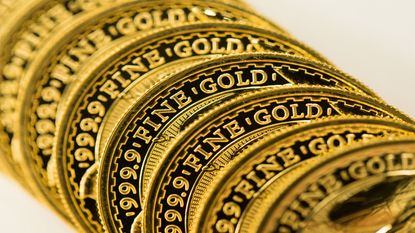Millennial investors push up demand for physical gold
The Royal Mint has seen the demand for precious metals and gold jump 200% as young investors turn to the yellow metal as an alternative to other assets, according to Andrew Dickey, the director of Precious Metals Investment at the Royal Mint.


Demand for physical gold around the world is rising, and it's not just investors who are buying the yellow metal.
According to the World Gold Council, last year demand for physical gold hit 4,741 tonnes, the highest level since 2011. The biggest buyers were the world's central banks. Central bank purchases of gold totalled 417 tonnes in the final quarter of the year.
To put that into perspective, the last time central banks acquired this much physical gold was in 1967 when less than $100 would buy you one ounce of gold. Today, one ounce of gold is worth around $1,830.
Subscribe to MoneyWeek
Subscribe to MoneyWeek today and get your first six magazine issues absolutely FREE

Sign up to Money Morning
Don't miss the latest investment and personal finances news, market analysis, plus money-saving tips with our free twice-daily newsletter
Don't miss the latest investment and personal finances news, market analysis, plus money-saving tips with our free twice-daily newsletter
The jump in buying by central banks is notable because, as Andrew Dickey, the director of Precious Metals Investment at the Royal Mint, explains, “it is always interesting, for the precious metals industry, what the central banks and the governments are doing. Big tectonic shifts in what they’re doing really impact the price of the metals.”
Overall, central banks acquired 1,136 tonnes of physical gold last year, a number only surpassed by retail investors. Demand by retail investors globally for gold bars and coins hit a new nine-year high last year of more than 1,200 tonnes.
Retail investors boost buying of physical gold
There’s been a notable increase in demand for physical precious metals here in the UK. “The big thing we’ve noticed, certainly in the UK since Covid, is the growth in small-scale retail investors,” Andrew Dickey says.
He believes there’s been a sharp change in sentiment among retail buyers over the past couple of years. These investors are now more willing to consider buying physical gold and silver than they have been in the past.
That’s evidenced by the explosion in investors buying from the Mint. The number of new Mint customers jumped 202% year-on-year from 2019 to 2020.
The precious metals producer saw a particular increase in demand after last year’s crypto crash, suggesting investors were dumping digital assets like bitcoin and moving into physical gold.
Indeed, the UK has traditionally lagged behind other countries when it comes to owning physical gold, but new routes into the gold and silver markets are opening up the space.
The Mint has introduced a series of smaller bars and coins at lower price points than the traditional one-ounce coins and larger gold bars. It’s also developed its DigiGold offering.
Digital gold attracts young investors betting on the gold price
DigiGold enables investors to buy fractional ownership of gold and silver bars. The digital asset is physically backed with precious metals stored in the Mint’s vaults, but it’s tradable at a click of a button.
This digital asset has become increasingly popular with younger investors. Before Covid, 11% of the Mint’s customers were classed as millennials. Today the number is closer to 29%. What’s more, younger investors are starting with digital gold, and then moving on to larger investments. “Those investors go on - still owning DigiGold - to buy a Britannia or a sovereign,” Andrew Dickey notes.
One benefit of buying Britannia or a Sovereign (both gold and silver) is the fact they’re authorised as “legal tender” by Royal Proclamation, in accordance with the Coinage Act of 1971. That means they are exempt from capital gains tax.
However, buying physical metal does have its drawbacks. Gold is hard to transport, difficult to store, and if you’re buying and selling it, you won’t get the spot (or market price).
The Mint offers a vaulting service for its customers buying gold directly through its platform. Investors can choose to store the metal in its vaults for a fee of up to 2% + VAT per year. There are other options out there for storing physical gold, although none are cheap.
Safety deposit boxes can be rented for a couple of hundred pounds a year from various providers or you can buy a safe for your home. If you chose this route you’ll need to tell your insurer and they might hike your home insurance. The benefit of deposit boxes is that they usually come with insurance as well.
If you’re buying physical gold and silver you’ll also pay a premium over the market price. This reflects the seller's costs, which can include refining the metal, verifying its authenticity and security.
Premiums can be 10% or more, depending on what you’re buying and if it’s a collector's item. You might also pay more going through a well-known and trusted provider like the Mint - that’s a trade-off many people are happy to make especially considering the value of the investment.
The DigiGold offering from the Mint gets around some of these issues. The cost of owning precious metals through the platform is only 0.5% + VAT per annum. “DigiGold charges a premium of 0.33%,” to buy fractional ownership of bars, explains Andrew Dickey. If you’re not interested in paying for the craftsmanship of decorative gold and silver bars, then this is the best way to invest at the lowest possible price.
Other ways to invest in physical gold
An even cheaper way to buy exposure to the yellow metal is via the Mint’s Gold ETC.
The Royal Mint Responsibly Sourced Physical Gold ETC is traded on the London Stock Exchange and charges just 0.25% per annum. The value of the ETC is backed by physical gold bars stored in the Mint’s vaults, and the shares can be redeemed for physical gold bars and coins at any time.
The ETC aims to help investors solve another issue that can act as a barrier to gold investing: its environmental footprint.
Green gold is becoming a reality
The gold industry has a huge, negative environmental footprint. We use energy to dig it up, refine it, and then, when we’ve done all of that, we dump it back underground in vaults and forget about it (although some gold is also used in electronics).
The Mint is making strides to reduce gold’s damaging footprint. It is building the world’s first plant to recover gold from UK electronic waste. At its peak the plant should be able to process 90 tonnes of UK-sourced circuit boards per week, generating “hundreds of kilograms of gold per year”.
Part of this gold will find its way into the ETC, part will also find its way into the Mint’s bars, coins and jewellery, giving what might have gone into landfill a new lease of life.
Considering the growing demand for physical gold in the UK and around the world, this recycling ability is sorely needed, although it won’t make much of a dent in the global market.
Despite this new supply, rising demand for physical gold, combined with the limited supply of the yellow metal could provide strong support for prices in the long term.
Rupert is the Deputy Digital Editor of MoneyWeek. He has been an active investor since leaving school and has always been fascinated by the world of business and investing.
His style has been heavily influenced by US investors Warren Buffett and Philip Carret. He is always looking for high-quality growth opportunities trading at a reasonable price, preferring cash generative businesses with strong balance sheets over blue-sky growth stocks.
Rupert was a freelance financial journalist for 10 years before moving to MoneyWeek, writing for several UK and international publications aimed at a range of readers, from the first timer to experienced high net wealth individuals and fund managers. During this time he had developed a deep understanding of the financial markets and the factors that influence them.
He has written for the Motley Fool, Gurufocus and ValueWalk among others. Rupert has also founded and managed several businesses, including New York-based hedge fund newsletter, Hidden Value Stocks, written over 20 ebooks and appeared as an expert commentator on the BBC World Service.
He has achieved the CFA UK Certificate in Investment Management, Chartered Institute for Securities & Investment Investment Advice Diploma and Chartered Institute for Securities & Investment Private Client Investment Advice & Management (PCIAM) qualification.
-
-
 Investment trust discounts hit 2008 levels. Here’s how to profit
Investment trust discounts hit 2008 levels. Here’s how to profitInvestment trust discounts have risen to levels not seen since 2008, here are three trusts looking to buy to profit.
By Rupert Hargreaves Published
-
 A luxury stock to buy at a high street price
A luxury stock to buy at a high street priceInvestors wrongly consider Watches of Switzerland a high-street outlet.
By Dr Matthew Partridge Published
-
 Investing in wine: how Cru Wine is reaching new audiences
Investing in wine: how Cru Wine is reaching new audiencesTips Gregory Swartberg, founder of fine wine specialist Cru Wine, talks to Chris Carter about how to start a wine collection
By Chris Carter Published
-
 Small companies with big potential
Small companies with big potentialMichael Taylor of Shifting Shares reviews his 2023 picks and highlights more promising minnows.
By Michael Taylor Published
-
 The MoneyWeek portfolio of investment trusts – July 2023 update
The MoneyWeek portfolio of investment trusts – July 2023 updateTips A decade ago we set up the MoneyWeek portfolio of investment trusts. They remain a compelling long-term bet says Rupert Hargreaves
By Rupert Hargreaves Published
-
 Women lead the way with ethical investments
Women lead the way with ethical investmentsDemand for more ethical investments has soared – and women are more likely to opt for them. Annabelle Williams, personal finance specialist at Nutmeg, takes a look at why.
By Annabelle Williams Published
-
 BoE: Mortgage payments to rise by £220 a month for households
BoE: Mortgage payments to rise by £220 a month for householdsMillions of households can expect a mortgage spike of around £200 a month - and some may even reach a extra £1,000 a month, the Bank of England warns
By Marc Shoffman Published
-
 What happened to Thames Water?
What happened to Thames Water?Thames Water, the UK’s biggest water company could go under due to mismanagement and debt. We look into how the company got itself into this position, and what investors should expect.
By Simon Wilson Last updated
-
 Where to invest in the metals that will engineer the energy transition
Where to invest in the metals that will engineer the energy transitionA professional investor tells us where he’d put his money. This week: John Ciampaglia, manager of the Sprott Energy Transition Materials UCITS ETF.
By Nicole García Mérida Published
-
 How investors can profit from high food prices
How investors can profit from high food pricesThe latest furore over grocery prices will die down, says David Stevenson. But the long-term outlook for soft commodities remains bullish. These are the stocks investors can buy to profit from high food prices.
By David J Stevenson Published









